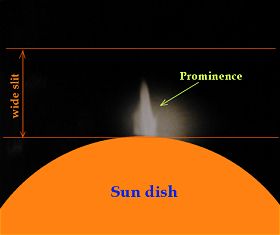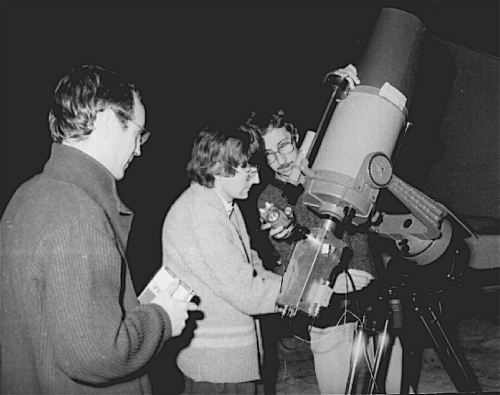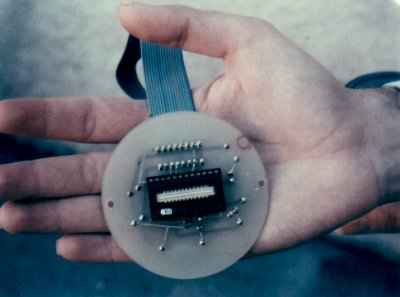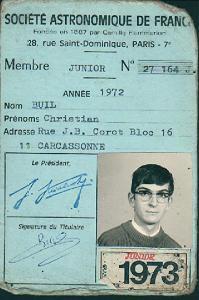A PERSONAL STORY OF THE
CCD ASTRONOMY
by Christian Buil
English translation by Thomas O'Hara
PART ONE: 1972-1984
|
|
In 1972, I jumped into amateur astronomy with both feet, by joining both the French Astronomical Association and the Astronomical Society of France. In the beginning I got involved by taking solar spectra, even before I observed Jupiter or M42!

My very first spectrum in 1973: bleue spectral region of the Sun, near the H&K Calcium lines, taken with a prism spectrograph (the collimator lens is my first astronomical instrument, a 2.4 inch refractor) and Kodak TRI-X film. Spectrography has always pursued me!


Left, my first "transportable" spectrograph. I use for this setup a surplus binocular lens and a 900 grooves/mm economical transmission grating (1976). Right, prominence observed with a similar spectrograph (4-inch PERL refractor). A large slit is tangent to the solar limb and prominences are visible into the H-alpha spectral line (July 1979, click here for details).
Then I specialized in meteor observing, founding the French Association of Meteor Observers. Finally, I also messed around with a soldering iron and played on the keyboard of my first computer, a PET Commodore, to thoroughly acquaint myself with photomultipliers, photodiodes, and photoelectric photometry. I pursued this line of study in Paris from 1978 to 1981, and in Toulouse in the south of France from 1982 to 1983.

Paris, 1978: From the balcony of a large apartment building (15eme arrondissement), I took my first photoelectric measurements. The detector was an RTC XP1115 photomultiplier tube. The signal, after leaving the photomultiplier tube, was amplified and read by a voltmeter if possible with a needle gauge to integrate the fluctuations of atmospheric scintillation! A first flip-mirror system served to center, approximately, the star under study. A second system permitted one to position the star at the center of a small measuring aperture, with the help of a microscope assembly. This is the ancestor of the CCD technique of numerical aperture photometry. The telescope used was an 8-inch, the primary mirror of which was signed by Jean Texereau. The greatest source of uncertainty in our measurements derived from our neighbors, who turned their apartment lights on and off more or less regularly!

October 1983, in the southern town of Carcassonne, with some members of the Alpha Centauri Astronomy Club (from left to right, Bernard Marlière, Christian Buil, Serge Chevrel). This was the maiden voyage of a completely new photometer, based on a photodiode. This detector was made of silicon from here it is not far to the CCD. Within at most six months, I had obtained a first CCD image…

My interest in photoelectric photometry led me to seek more and more sensitive detectors. Then, at the end of 1983, I discovered the CCD in its simplest form: a single line of pixels, called a ‘linear array.’

Early 1984: the first CCD camera. The last photodiode photometer was transformed by adding the cylindrical part to the rear, which contains the round CCD printed circuit board. An off-axis guider facilitates pointing the CCD. The whole thing is mounted on a good old Celestron 8.

The computer card of the first CCD camera. It is in fact a double card, connected by one of the slots to the Apple IIe bus, which is visible in the back. The electronics are minimal: a clock circuit, and 8-bit analog-to-digital converter, and an amplifier control circuit. You can also see the voltage regulator to the left. Another card in the second row supports the interface circuits (PIA 6821) with the computer bus.

This image of the Moon’s Mare Crisium was one of the first ever obtained by an amateur astronomer with a CCD chip. The single line of pixels was arranged perpendicularly to the apparent motion of the sky, and the Celestron 8’s clock drive was shut off. Then, by synchronizing the displacement of the image at Cassegrain focus (caused by the Earth’s rotation) with the CCD reading, the image was built line by line. In other words, this was the ‘drift-scan’ method of imaging, long before the term was coined. In those days, the only celestial objects that were reasonably accessible to this technology were the Sun, the Moon, and the brighter planets. This image is a photograph of a television screen. In the Apple IIe it was possible to create some colors by interpolation, using a graphics card which was extraordinary (and expensive) for its time, the famous ‘Mauve Cat’ card (‘Up to 16 colors simultaneously!’).

In 1984, computer science did what it could. The computer, an Apple IIe, was cutting edge at the time, nevertheless the machine was extraordinarily poorly suited to image processing. The monitor could display only 8 to 16 colors, and a single shade of grey. It was necessary to scheme with clever contrivances just to simulate a pale shade of grey. To trace isophotes here of the intensity of the floor of Mare Crisium we had to resign ourselves to compiling the image from a great number of binary images, which corresponded to each of the judiciously chosen steps in its 8-bit dynamic range. Then, with tracing paper, we would patiently record the contours of each image. In those days, to produce one such image took a good hour of work; today, it takes one second!

This picture, printed out with a pen-recorder, shows the first image of a stellar object made with a Thomson TH7801A linear array chip. It was formed by allowing the sky to drift across the detector. It shows the double star ß Cygni (‘Albireo’). In order to increase the exposure time (here, on the order of one second), it was necessary to run the telescope’s clock drive, but at a speed which was significantly slower than the normal sidereal rate. Image displacement at Cassegrain focus thus occurred in slow motion. Image scale was increased by eyepiece projection, using a 20mm eyepiece at the Celestron’s Cassegrain focus. To drift the image quite uniformly across the focal plane, while maintaining an identical scale across both axes, was a real high-wire act!

The system of single-line CCD imaging was described in a text, Using a CCD in Amateur Astronomy, which was first disseminated by photocopy. Then in January 1987 it was printed by the Astronomical Society of Hérault in a limited edition of 100 copies (the cover of which is shown above). Finally it was issued in book form in 1989 in France, as Astronomie CCD, by the Popular Astronomy Society in Toulouse (large town in south of France); and in 1991 in the United States as CCD Astronomy, by Willmann-Bell.

